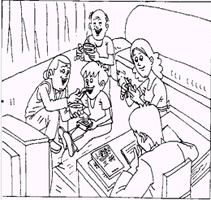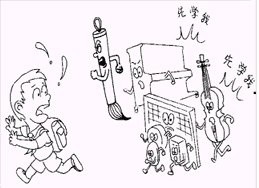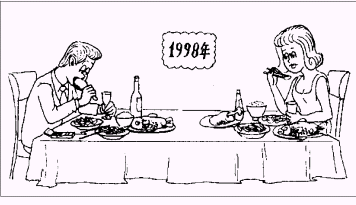Section I Listening Comprehension,
Part A
You will hear a recording of a conversation between Mary and John
about the Hilton Hotel and the Hotel Rossiya. Listen to it and
fill out the table with the information you've heard for questions
1-5. Some of the information has been completed for you. Write not
more than 3 words in each numbered box. You will hear the
recording twice. You now have 25 seconds to read the table below.
| Information about the Hilton Hotel and the
Hotel Rossiya |
| |
The Hilton Hotel |
|
The Hotel Rossiya |
|
| Number of Bedrooms |
|
1 |
3,200 |
|
| Number of Employees |
|
2 |
3,000 |
|
| Number of Restaurants |
12 |
|
|
3 |
| Number of Elevators |
 |
|
|
4 |
| Country of Location |
U.S. |
|
|
5 |
Tapescript:
M: Hi, Mary. How's everything?
W: Fine. You know, John, I'm planning to go to
Las Vegas for a holiday and would like to stay in a large hotel.
Anything to recommend?
M: Er? the Hilton Hotel there is quite a large
one. It has ? er ? 3,174 bedrooms. It also has 12 restaurants and
about 125,000 square feet of convention space. There're a 10-acre
recreation deck and a stage show dining hall. Over 3,600 people
now work for it.
W: Oh, great! Is it the largest hotel in the
U.S.?
M: Yes, it is. But it may not be the largest in
the world. Er ? as far as I know, the Hotel Rossiya in Moscow is
larger than Hilton. It is a 12-story building that has 3,200
rooms. It can provide accommodation for 6,000 guests. It takes
nearly 8 years and a half to spend one night in each room.
Besides, there's a 21-story "Presidential tower" in the
central courtyard. It has 15 restaurants and 93 elevators. And it
employs about 3,000 people. The ballroom is known as the world's
largest. Russians are not allowed to live in that hotel. And
foreigners are charged 16 times more than the very low rate
charged Russian officials.
W: It's unbelievable ?[fade out]
Now you will hear the recording again. (The recording is
repeated.)
That is the end of Part A.
Part B
You will hear a radio weather forecast. Answer questions 6-10
while listening. Use not more than 5 words for each answer. You
will hear the recording twice. You now have 40 seconds to read the
questions.
| When will showers reach south-west England
and the southern coast of Wales? |
|
| What will the minimum temperature be in the
south during the night? |
|
| On what day of the week do you think this
weather forecast was given? |
|
| What will be the general feeling about the
weekend in the Netherlands? |
|
| What part of England will be cloudy and dry
over the weekend? |
|
Tapescript
W: Hello. It's been another warm and fine
day for most of us. Temperatures in south-east England reached
twenty-six degrees Centigrade by mid-afternoon, and Brighton had
fifteen hours of lovely sunshine. But already the weather is
beginning to change, I'm afraid, and during the night showers will
slowly move in from the Atlantic to reach south-west England and
the southern coast of Wales by early morning.
The rest of the country will have a very mild, dry night with
minimum temperatures no lower than fifteen degrees in the south, a
little cooler ? eleven degrees or so ? in the north. Any remaining
showers in northwest Scotland will pass quickly, to leave a mild,
dry night there too.
And now, the outlook for Friday and the weekend. Well, southern
Europe will once again get the best of the weekend weather, and if
your holiday starts this weekend, then southern Spain is the place
to go, with temperatures of thirty-four degrees along the
Mediterranean coast. At the eastern end of the Med, too, you can
expect uninterrupted sunshine and temperatures of up to thirty-two
degrees Centigrade in Greece and south-east Italy, but further
north the weather's not so settled. Much of France, Belgium and
the Netherlands will be cloudy with occasional rain and maximum
temperatures will be around twenty-two degrees ? very
disappointing for this time of the year.
Scotland and Northern Ireland will have heavy rain for much of the
weekend and temperatures will drop to a cool seventeen degrees.
Across most of England the weather will be cloudy but mainly dry
with sunny periods. And when the sun does come out temperatures
could rise to a maximum of twenty-three degrees.
Now you will hear the recording again. (The recording is
repeated.)
That is the end of Part B.
Part C
You will hear three dialogues or monologues. Before listening to
each one, you will have time to read the questions related to it.
While listening, answer each question by choosing A, B, C or D.
After listening, you will have time to check your answer. You will
hear each piece once only.
Questions 11-13 are based on the following talk introducing Emily
Dickinson, a well-known American poet. You now have 30 seconds to
read questions 11-13.
11. How long did Emily Dickinson live in the house where she was
born?
[A] almost all her life
[B] less than half her life
[C] until 1830
[D] before 1872
12. Which of the following is true of Emily Dickinson?
[A] She was not a productive poet.
[B] She saw many of her poems published.
[C] She was not a sociable person.
[D] She had contact only with a few poets.
13. When was Emily Dickinson widely recognized?
[A] after Henry James referred highly to her
[B] after seven of her poems were published
[C] after her poems became known to others
[D] after she was dead for many years
Tapescript:
M: Emily Dickinson is one of the greatest
American poets. She was born in a typical New England village in
Massachusetts on December 10, 1830. She was the second child of
the family. She died in the same house fifty-six years later.
During her life time she never left her native land. She left her
home state only once. She left her village very few times. And
after 1872 she rarely left her house and yard. In the last years
of her life she retreated to a smaller and smaller circle of
family and friends. In those later years she dressed in white,
avoided strangers, and communicated chiefly through notes and
poems even with intimates. The doctor who attended her illness was
allowed to "examine" her in another room, seeing her
walk by an opened door. She was thought of as a
"strange" figure in her home village. When she died on
May 15, 1886, she was unknown to the rest of the world. Only seven
of her poems had appeared in print.
But to think Emily Dickinson only as a strange figure is a serious
mistake. She lived simply and deliberately. She faced the
essential facts of life. According to Henry James, a famous
American novelist, she was one of those on whom nothing was lost.
Only by thus living could Dickinson manage both to fulfill her
obligations as a daughter, a sister, and a housekeeper and to
write on the average one poem a day.
She read only a few books but knew them deeply. Her poems are
simple but remarkably rich. Not until 1950s was she recognized as
one of the greatest American poets.
Section II Use of English
Read the following text. Choose the best word for each numbered
blank and mark A, B, C or D on ANSWER SHEET (1).
During the 1980s, unemployment and underemployment in some
countries was as high as 90 per cent. Some countries did not 1
enough food; basic needs in housing and clothing were not(2) .
Many of these countries looked to the industrial processes of the
developed nations (3) solutions.
(4) , problems cannot always be solved by copying the
industrialized nations. Industry in the developed nations is
highly automated and very(5) . It provides fewer jobs than
labor-intensive industrial processes, and highly (6) workers
are needed to(7)and repair the equipment. These workers must
be trained, (8) many nations do not have the necessary
training institutions. Thus, the (9) of importing industry
becomes higher. Students must be sent abroad to (10)
vocational and professional training. (11) , just to begin
training, the students must (12) learn English, French,
German, or Japanese. The students then spend many years abroad,
and (13) do not return home.
All nations agree that science and technology (14) be shared.
The point is: countries (15) the industrial processes of the
developed nations need to look carefully (16) the costs,
because many of these costs are (17) . Students from these
nations should (18) the problems of the industrialized
countries closely. (19) care, they will take home not the
problems of science and technology, (20) the benefits.
| 1. |
[A]generate |
[B]raise |
[C]produce |
[D]manufacture |
| 2. |
[A]answered |
[B]met |
[C]calculated |
[D]remembered |
| 3. |
[A]for |
[B]without |
[C]as |
[D]about |
| 4. |
[A]Moreover |
[B]Therefore |
[C]Anyway |
[D]However |
| 5. |
[A]expensive |
[B]mechanical |
[C]flourishing |
[D]complicated |
| 6. |
[A]gifted |
[B]skilled |
[C]trained |
[D]versatile |
| 7. |
[A]keep |
[B]maintain |
[C]retain |
[D] protect |
| 8. |
[A]since |
[B]so |
[C]and |
[D]yet |
| 9. |
[A]charge |
[B]price |
[C]cost |
[D]value |
| 10. |
[A]accept |
[B]gain |
[C]receive |
[D]absorb |
| 11. |
[A]Frequently |
[B]Incidentally |
[C]Deliberately |
[D]Eventually |
| 12. |
[A]soon |
[B]quickly |
[C]immediately |
[D]first |
| 13. |
[A]some |
[B]others |
[C]several |
[D]few |
| 14. |
[A]might |
[B]should |
[C]would |
[D]will |
| 15. |
[A]adopting |
[B]conducting |
[C]receiving |
[D]adjusting |
| 16. |
[A]to |
[B]at |
[C]on |
[D]about |
| 17. |
[A]opaque |
[B]secret |
[C]sealed |
[D]hidden |
| 18. |
[A]tackle |
[B]learn |
[C]study |
[D]manipulate |
| 19. |
[A]In |
[B]Through |
[C]With |
[D]Under |
| 20. |
[A]except |
[B]nor |
[C]or |
[D]but |
Section III Reading Comprehension
Part A
Read the following four texts. Answer the questions below each
text by choosing A, B, C or D. Mark your answers on ANSWER SHEET
1.
It was 3:45 in the morning when the vote was finally taken.
After six months of arguing and a final 16 hours of hot
parliamentary debates, Australia's Northern Territory became the
first legal authority in the world to allow doctors to take the
lives of incurably ill patients who wish to die. The measure was
passed by the convincing vote of 15 to 10. Almost immediately word
flashed on the Internet and was picked up, half a world away, by
John Hofsess, executive director of the Right to Die Society of
Canada. He sent it on via the group's on-line service, Death NET.
Says Hofsess: "We posted bulletins all day long, because of
course this isn't just something that happened in Australia. It's
world history."
The full import may take a while to sink in. The NT Rights of the
Terminally Ill law has left physicians and citizens alike trying
to deal with its moral and practical implications. Some have
breathed sighs of relief; others, including churches,
right-to-life groups and the Australian Medical Association,
bitterly attacked the bill and the haste of its passage. But the
tide is unlikely to turn back. In Australia ? where an aging
population, life-extending technology and changing community
attitudes have all played their part ? other states are going to
consider making a similar law to deal with euthanasia. In the U.S.
and Canada, where the right-to-die movement is gathering strength,
observers are waiting for the dominoes to start falling.
Under the new Northern Territory law, an adult patient can request
death ? probably by a deadly injection or pill ? to put an end to
suffering. The patient must be diagnosed as terminally ill by two
doctors. After a "cooling off" period of seven days, the
patient can sign a certificate of request. After 48 hours the wish
for death can be met. For Lloyd Nickson, a 54-year-old Darwin
resident suffering from lung cancer, the NT Rights of Terminally
Ill law means he can get on with living without the haunting fear
of his suffering: a terrifying death from his breathing condition.
"I'm not afraid of dying from a spiritual point of view, but
what I was afraid of was how I'd go, because I've watched people
die in the hospital fighting for oxygen and clawing at their
masks," he says.
1. From the second paragraph we learn that
[A] the objection to euthanasia is diminishing in some countries.
[B] physicians and citizens have the same view on euthanasia.
[C] technological changes are chiefly responsible for the new law.
[D] it takes time to appreciate the significance of laws passed.
2. By saying that "observers are waiting for the dominoes to
start falling", the author
means that
[A] observers are taking a wait-and-see attitude towards the
future of euthanasia.
[B] there is a possibility of similar bills being passed in the
U.S. and Canada.
[C] observers are waiting to see the movement end up in failure.
[D] the process of the bill taking effect may finally come to a
stop.
3. When Lloyd Nickson is close to death, he will
[A] undergo a cooling off period of seven days.
[B] experience the suffering of a lung cancer patient.
[C] have an intense fear of terrible suffering.
[D] face his death with the calm characteristic of euthanasia.
4. What is the author's attitude towards euthanasia?
[A] Hostile.
[B] Suspicious.
[C] Approving.
[D] Indifferent.
5. We can infer from the text that the author believes the success
of the right-to-die
movement is
[A] only a matter of time.
[B] far from certain.
[C] just an illusion.
[D] a shattered hope.
Part B
Read the following text carefully and then translate the
underlined segments into Chinese. Your translation should be
written clearly on ANSWER SHEET 2.
Do animals have rights? This is how the question is usually put.
It sounds like a useful, ground-clearing way to start. 61)
Actually, it isn't, because it assumes that there is an agreed
account of human rights, which is something the world does not
have.
On one view of rights, to be sure, it necessarily follows that
animals have none. 62) Some philosophers argue that rights exist
only within a social contract, as part of an exchange of duties
and entitlements. Therefore, animals cannot have rights. The idea
of punishing a tiger that kills somebody is absurd; for exactly
the same reason, so is the idea that tigers have rights. However,
this is only one account, and by no means an uncontested one. It
denies rights not only to animals but also to some people ? for
instance, to infants, the mentally incapable and future
generations. In addition, it is unclear what force a contract can
have for people who never consented to it: how do you reply to
somebody who says "I don't like this contract"?
The point is this: without agreement on the rights of people,
arguing about the rights of animals is fruitless. 63) It leads the
discussion to extremes at the outset: it invites you to think that
animals should be treated either with the consideration humans
extend to other humans, or with no consideration at all. This is a
false choice. Better to start with another, more fundamental,
question: is the way we treat animals a moral issue at all?
Many deny it. 64) Arguing from the view that humans are different
from animals in every relevant respect, extremists of this kind
think that animals lie outside the area of moral choice. Any
regard for the suffering of animals is seen as a mistake ? a
sentimental displacement of feeling that should properly be
directed to other humans.
This view, which holds that torturing a monkey is morally
equivalent to chopping wood, may seem bravely "logical".
In fact it is simply shallow: the confused center is right to
reject it. The most elementary form of moral reasoning ? the
ethical equivalent of learning to crawl ? is to weigh others'
interests against one's own. This in turn requires sympathy and
imagination: without which there is no capacity for moral thought.
To see an animal in pain is enough, for most, to engage sympathy.
65) When that happens, it is not a mistake: it is mankind's
instinct for moral reasoning in action, an instinct that should be
encouraged rather than laughed at.
Section IV Writing
Widespread tobacco consumption has led to grave consequences, yet
the tobacco companies are still claiming that they make a valuable
contribution to the world economy.
Write an essay
1) criticizing their view and
2) justifying your stand.
In your essay, make full use of the information provided in the
pictures printed below.
You should write approximately 160 ? 200 words on ANSWER SHEET 2.

ORAL TEST
Part A
Interlocutor:
1,Good morning/afternoon. Could I have your mark sheets, please?
Thank you.
(Hand over the mark sheets to the Assessor)
2,My name is ...and this is my colleague ... He/she is just
going to be listening to us. So, you are ... and ...? Thank you.
3,First of all we'd like to know something about you, so I'm
going to ask some questions about yourselves.
(Select one or more questions from each of the following
categories as appropriate.)
Hometown
1,Where are you from?
2,How long have you lived there?
3,What's it like living there?
Family
· What can you tell me about your family?
Work / Study
· Can you tell me something about your work or studies?
(To a student)
· What do you specialize in?
· What do you enjoy most about your studies?
· What subject(s) do you like best?
· Have you ever worked during the vacation?
· What kind of job did you do?
· How did you like it?
(To an adult who already has a job)
· What job do you do?
· Do you like it? And why?
· What qualifications did you need in order to get your
"job"?
Leisure
· Do you have any hobbies?
· How did you become interested in (whatever hobby the candidate
enjoys)?
· Which do you prefer, watching TV or going to the cinema? What
sort of
program / film do you like to watch?
· What kinds of sports are you interested in? Why?
· What kinds of music do you enjoy most? Why?
· How do you usually spend your holidays?
· Is there anywhere you would particularly like to visit? Why?
Future Plans
· What do you hope to do in your professional life in the next
few years?
· How important is English for your future plans? And please give
reasons to
support your view.
Part B
Interlocutor:
· Now I'd like you to talk about something between yourselves but
speak so that
we can hear you. You should take care to share the opportunity of
speaking.
(Put the picture in front of both candidates and give instructions
with reference to
the picture.)
· You have a very close friend whose birthday is coming. Discuss
each of the
choices shown in the picture and decide which you'd like to choose
for
celebrating his birthday. Give reasons for your decision.
· This picture is for your reference.
· You have three minutes for this.
· Would you like to begin now, please?
Picture

Part C
Interlocutor:
· I'm going to give each of you a picture and I'd like you to
first briefly describe
and then give your comment on what you see in the picture.
(Put Picture 1 in front of both candidates)
· Candidate A, this is your picture. You have three minutes to
talk about it.
· Candidate B, listen carefully while Candidate A is speaking.
When he/she
has finished, I'd like you to ask him/her a question about what
he/she has said.
· Candidate A, would you like to begin now, please?
Candidate A: (three minutes)
Interlocutor:
· Thank you. Now, Candidate B, could you please ask your partner
a question?
(Half a minute for asking and answering the question)
(Take back Picture 1 and put Picture 2 in front of both
candidates)
· Ok, Candidate B, here is your picture. You also have three
minutes to talk about
your picture.
· Candidate A, listen carefully while Candidate B is speaking.
When he/she is
finished, I'd like you to ask him/her a question about what he/she
has said.
· Candidate B, would you like to begin now, please?
Candidate B: (Three minutes)
Interlocutor:
· Thank you. Now, Candidate A, could you please ask your partner
a question?
(Half a minute for asking and answering the question)
· Thank you. That is the end of the test.
Picture 1
Picture 2
Distance
|





